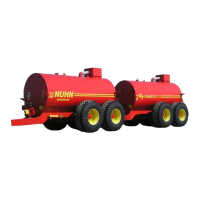MAGNUM
Page 12
7. Safety Decals on the Spreader
Hydrogen sulfide is formed as a result of the decomposition of organic material. It is a
clear, colourless gas and can be recognized in small concentration by its rotten egg
odour. However, human ability to smell this gas disappears rapidly as a result of
continued exposure and with increased exposure.
Liquid manure systems can produce relatively large concentrations of hydrogen sulfide (as well
as carbon dioxide). Many barns are constructed with slatted floors directly over the liquid
manure tank. As the liquid rises and may eventually be forced above the floor. Confined
livestock are in danger under these circumstances. The greatest danger period from hydrogen
sulfide occurs during the agitation of the tanks. The turbulence created may cause trapped
gases to be liberated and may force gas up into the barn.
Hydrogen sulfide is classified as a toxic chemical. In high concentration, it will lead to
almost instantaneous poisoning and death. Exposure to smaller concentrations
may cause nausea, coughing, headache, dizziness, and eye irritation.
All sources of entry into a liquid manure system should be secured. Prior to agitation and
pumping, all people and animals should be evacuated from the barn. Thorough ventilation
should be provided during agitation and pumping process.
NOTE* Safety screen should always be in the fill hole.
NO ONE should ever enter a liquid manure holding tank or a spreader without
following these rules for confined space entry:
• wash out spreader using wash system and re circulate
• remove cleanout doors
• blow air in the top hopper using a large fan for at least 30 minutes
• use a Hydrogen Sulfide Detector
• use a self controlled breathing device
• use a life line
DO NOT go into the tank after a downed person, you will be overcome too.

